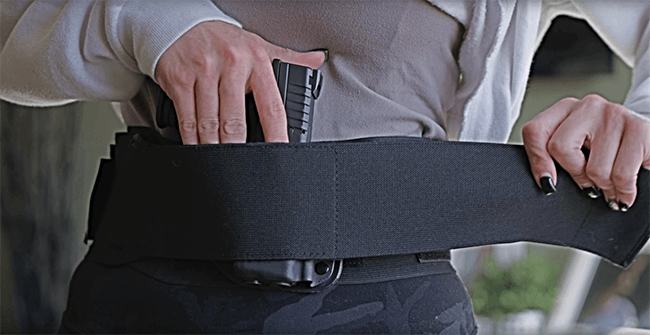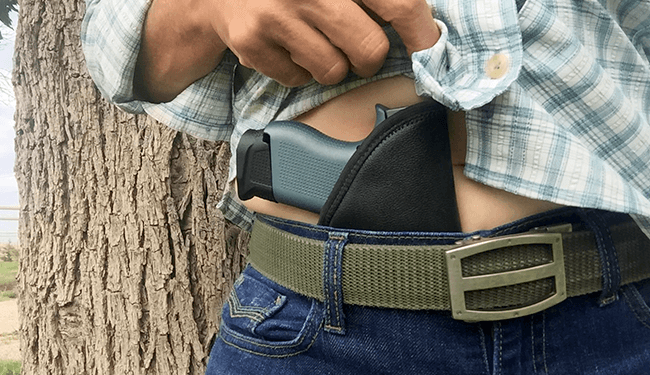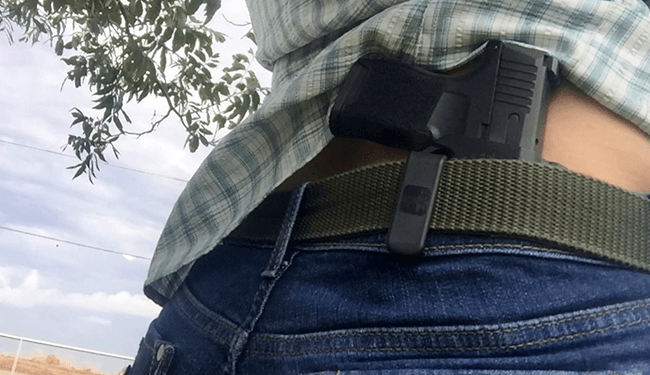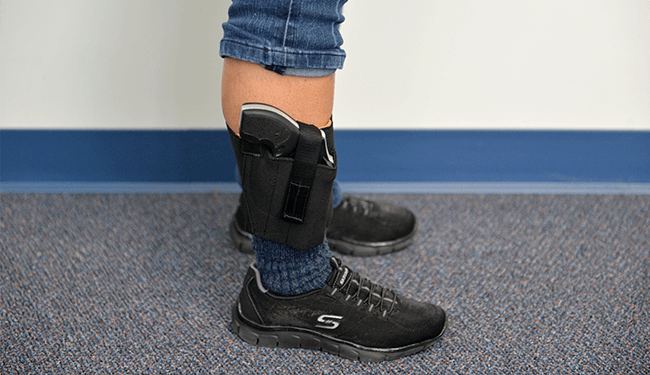Ladies, Make the Move to On-Body Carry: You Won’t Be Alone!
By Eve Flanigan
It’s been nearly two decades since concealed carry licensing programs were widely established in the United States. In that time, my own carry habits as well as those I hear about from female students have evolved for the better. More women are carrying all the time when they leave their home or car. That’s wonderful, because the gun that’s not with you cannot save you!
Equally impressive is the trend I’ve noticed among women who have carried for several years. More guns today are being carried on-body rather than in a purse or other off-body holster arrangement. That’s encouraging too, as off-body carry is fraught with complications including safety and theft risks. While on-body carry methods are not without hazards or training recommendations, most are far less complicated than off-body carry and present less risk to those around the person carrying.
So, if on-body carry is generally preferable, what are the options? Today’s concealed carry industry actually has more options for women than for men, but here are two rules to speed up the process of sifting the gold nuggets from what can seem like a mountain of dirt.
- Eliminate any form of carry that doesn’t adequately shield the trigger guard. Your carry method must allow nothing to penetrate the trigger guard while the gun is in its carry location. That means no holster-less pocket carry, and you’ll also decline any holster product that’s too soft to resist outside pressure (like baby toes, dog claws or any other object) while the carry system is in use. That may mean different holsters for different clothing. For instance, a holster system that is adequate under the stiff fabric of jeans may be safe, but may not be remain risky under only a shirt or skirt.
- Eliminate options that don’t securely retain the firearm in the holster. A few holsters offer no retention abilities at all (ask me about the time I felt my gun oozing its way out of my belly band holster during a business meeting!). Others offer an acceptable level of retention when worn in combination with a snug belt or drawstring.
Daily activities should be taken into consideration when thinking about retention. If your profession or other routines require climbing, crawling and the like, retention, usually built around a good belt, must be rock-solid. If your routine includes being the recipient of physical contact, whether in the form of hugs or being in crowded quarters, deeper concealment methods will be necessary.
Holster Basics
There are dozens of ways to carry a firearm on-body. After eliminating the ones that don’t meet the safety criteria above, there are still a number of common choices that could pass muster. Here they are in relative order of preference in terms of immediate access to the firearm, along with pros and cons for each.
Outside-the-waistband, worn under a shirt or jacket

This bellyband holster from Crossbreed is an outside-the-waistband holster that adjusts to accommodate a wide variety of body types.
The “OWB” carry position at the hip offers the most natural draw stroke (assuming one has trained to efficiently clear the shirt or jacket that’s covering the gun). A form-fitting holster can prevent “printing,” the term for an obvious gun-shaped bulge protruding from underneath the cover garment. If your body shape and manner of dress can conceal a gun OWB, this method would be ideal. If you have a muffin top that would tilt the grip outward, I’d look for a different carry option.
Inside-the-waistband worn at the appendix or hip

The inside-the-waistband developed by Comfort Cling does not require belt attachment. It is shown worn in the appendix position.
A number of holsters made of Kydex, neoprene, leather or combinations thereof are made to be worn inside the waistband at the hip or frontal (appendix) area. Appendix-inside-waistband (AIWB) carry offers quick access, as well as making the gun nearly grab-proof. As beneficial as this carry position can be, this method should not be used by people who have not developed excellent discipline in terms of keeping fingers out of the trigger guard and awareness of where your muzzle is at all times during the draw and presentation.
Inside-the-waistband worn behind the body’s midline

This Bravo Concealment holster clips over the waistband and belt. Shown here in the 4 o’clock behind-the-body position.
Wearing the firearm at your back, behind your body’s midline (between four- and six-o’clock for right-handed shooters or between six- and eight- o’clock for left-handed carriers), can be surprisingly comfortable, even with a mid-size firearm. On the downside, printing, and/or your cover garment hanging up on the grip, is almost inevitable when bending over (especially with firearms that have rubber grips). If that’s not enough to dissuade you, a disturbing number of security camera videos have documented the theft of guns from this carry position when the wearers are naturally focused on whatever is in front of them.
This is another holster position that will likely not work well if you are very overweight or lack the flexibility to reach behind yourself to properly access your grip, especially when doing so under your cover garment. Regardless if these are issues for you, accessing your firearm from this position, clearing the cover garment and making a clean, efficient draw takes practice, practice, practice, and like the IWB appendix position, you must be expert at keeping your finger out of the trigger guard before you’re on target and aware of your muzzle at all times during the draw and presentation.
Most holsters made for waistband carry (both inside and out) require use of a sturdy belt to keep the gun from printing or flopping around. A fashion belt is not enough. Companies like Nexbelt make low-profile, highly adjustable belts that are great companions for OWB and IWB holsters.
Ankle systems
Ankle holsters range in styles from a modern wrap-around neoprene cuff to a harness-like contraption that has a garter band worn just under the knee and attached by straps to the holster which is best worn on the inside of the support side (strong-side) ankle. While drawing from an ankle holster requires dramatic movement and, if the gun is secured with Velcro, audible effort, this is a very low-profile way to carry.
Traditional ankle holsters, worn all day, call for a tiny gun. Be aware that, unless it’s worn over a tall sock, the calf garter will likely abrade skin from that area. A neoprene wrap-style holster can eliminate that discomfort but adds sweat. I know one woman who successfully manages ankle carry. She pairs a Ruger LCP in a traditional harness-style rig to which she added sheepskin lining. She worked long shifts behind a counter in this setup.
With an ankle holster you will need to be aware of exposure when doing anything but standing. Sitting, crouching, kneeling and climbing will all pull up the fabric of the pants you’re wearing, easily revealing the gun to anyone around you. That’s something you’ll need to keep in mind when getting in and out of a vehicle, going to a restaurant to sit down for lunch, climbing a ladder, etc.
A Note About Shoulder Rigs
While there are a variety of shoulder holsters available, they’re simply not as popular as they once were. They require a jacket be worn at all times, as well as a belt so the holster and, usually, the magazine holders on the other side, are tied down. Certainly, if such clothing is part of your everyday wear, a shoulder holster can be considered, especially if you’ve found carrying at the waist isn’t ideal for your body type or situation.
You may also be interested in:
https://www.letsgoshooting.org/2019/05/09/how-big-of-a-deal-is-conceal-carry/
https://www.letsgoshooting.org/2019/10/03/10-top-handguns-for-women/
